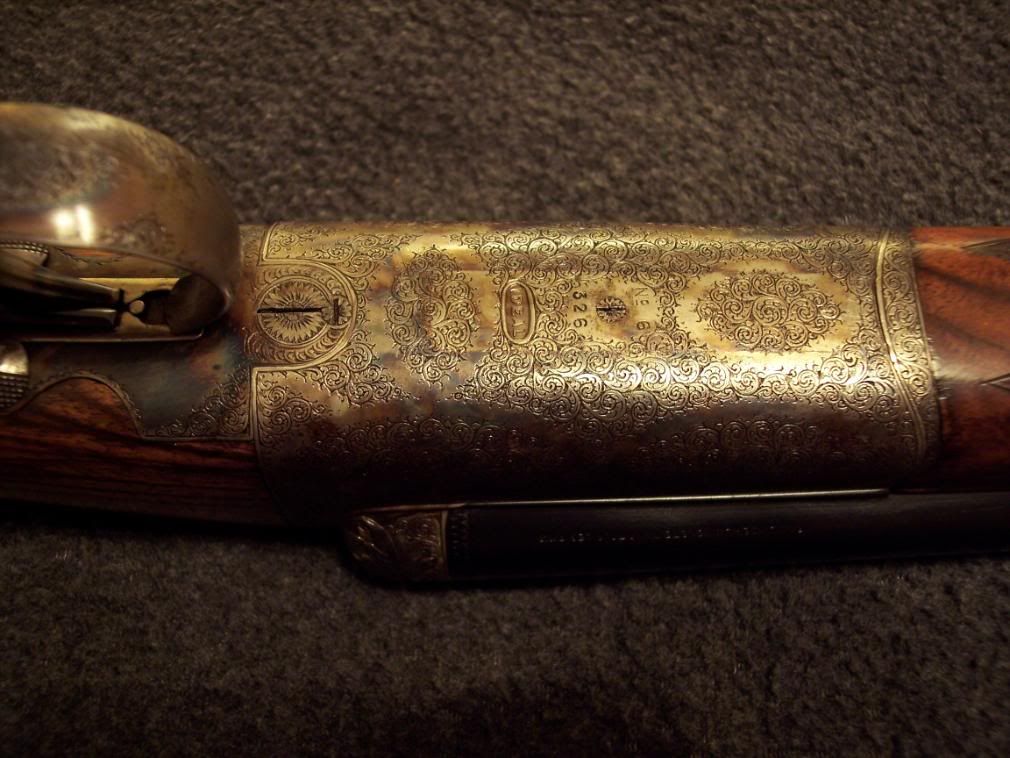Neat gun. Check it out:
http://www.gunbroker.com/Auction/ViewItem.aspx?Item=152039970What's up with the firing pins as shown in pic #5?
Why are there 2 sets of holes? And why are the pins so far to the edge?
Thanks
OWD
Loaded chamber indicators.
Dang - I think you're right. Those are the outside pins, right?
So where are the indicators on the outside of the gun?
Thanks
OWD
Somewhere on the fence balls?
They don't really show the top of those fences do they -- wonder what's there to hide.
They are hidden behind the "breech balls"..when a chamber is loaded, they protrude from the back as little "bumps", if there is engraving in this area...they are nearly impossible to notice unless there is a shell in the chamber and you are shown where the "bumps" are at. Very sneaky ;-)
If you look at the second picture down....the indicator would be located right behind the "oak leaf" where the breech ball meets the front of the action.
This is a very nice Ideal and I would gladly pay the asking price....if it didnt have the lunnette style trigger guard :-(
Its a wonderful gun and would make an extremely nice addition to any collection. 5 palms barrel steel as well, its a fantastic gun.
Dustin
Are the stocks on more of them reinforced like this one?
Those triggers look like they would take some getting used to.
What does the other style trigger guard look like?
Thanks
OWD
The higher grade Ideals had those metal bands on the stocks, I guess more space for the engraver to ply his trade or to show off the craftsmanship of fitting that piece to the gun (aka more time, more money). The "other trigger guards" would be found on later Ideals, usually on ones made in the 20th century. and they would be what we would call a standard style guard found on virtually all other guns we own with some sculpting/shaping differences.
Another nice thing about this gun is that the sling+mechanism seems to be all there, another nice touch. Someone please buy this gun....like quick. :-)
Get a Ideal in your hands and be prepared to be amazed. There are so many cool things about these guns...you can decock them, you can cock them by pulling the lever up when the gun is closed, you can take the barrels off without ever taking the forend off, the fitting of the rising bite is out of this world, the internals are very cool too. Its one of the most interesting, practical, and innovative game guns ever devised, my opinion of course.
Dustin
Found this pic of the other kind of triggerguard:
http://stephenbodio.blogspot.com/2006/08/gunblogging-french-design-2.htmlThey sound like neat guns. I'll keep my eye out for a 16 with a regular triggerguard.
I love the sling, too. Great idea.
Have a good New Year,
OWD
From collectible point of view 2-eyes trigger guard is superior to ordinary trigger guard. Actually 2-eyes TG is like trademark of Ideal.
Are the stocks on more of them reinforced like this one?
Those triggers look like they would take some getting used to.
What does the other style trigger guard look like?
Thanks
OWD
It doesn't take any time to get use to the eye guard.
They are great guns just like LeFusil said. I hope to own many more!

Jaqua's also has one on their list, without the "lunettes" trigger guard.
I had a pretty basic one that had been restocked, and not too well. The one thing that bothered me, as a field gun, was that the safety is bass-ackwards: you slide it BACK to take it off safe.
The one Dustin owned is indeed a beautiful gun.
From collectible point of view 2-eyes trigger guard is superior to ordinary trigger guard. Actually 2-eyes TG is like trademark of Ideal.
Maybe in Europe this is true, not here in the U.S. There just arent enough Ideals in this country to collect, if you find one and you want one, you buy it because you probably wont see another one like in a very long time.
Most hunters here will be wearing gloves at some point during the upland season, this is where the "eyeglass" or "lunnette" trigger guard becomes a bit cumbersome. And I believe if it was "superior" to the standard type trigger guard, Manufrance would've kept putting them on their guns right up until the end.
. . . and the lever does it all, pulls back the double underbite, pulls down and returns the bifurcated rising bite, cocks the "catapult" type strikers. Now that my lever return spring is in, gun reassembled, the "arrowheads" of checkering recut at head of stock and stock refinished with slackum, I should be busy right now fabricating a replacement sling disconnect for mine (retract mech is good) but I got distracted by a cheap marine gps plotter program with PC as the chartplotter (just out on the road with the whole rig and a DC/AC inverter a few minutes ago). And Xmas got in the way also. Should ask if the original disconnect is brass or steel? I think brass might not be rigid enuf given the delicate dimensions of the yoke arms. Very good fotos of the disconnect in the GunBroker ad; obvious how the upper lip of the disconnect fairs into the steel keeper inlet in the stock and shows the engraving. Are the "stopper" horns on the disconnect always crosshatched?
EDIT: I see now that the disconnect is definitely steel.
jack
Jack,
The connector piece is steel, probably mild. The horns are generally crosshatched, which you can do with some very small files.
I have the same type of project coming up along with a new stock for a 16 ga that has excellent barrels and a very nice action.
Larry, the first Idéals did not have a safety. You close the gun uncocked and cock it
by pulling the lever as you mount to shoot. Forget the safety.
Lapin, the sling disconnect, as you surmised, is steel, and not that mild. I had to go at
one and it was quite hard.
It should be noted that the original patent for Idéals is from 27 October 1887, and it
had a "normal" trigger guard. The "eyeglass" guards appeared in the first guns and
were discontinued in 1909.
Here is mine with "classic" trigger guard.

JC
In the orifginal USA patente it have lunnete triggerguard.
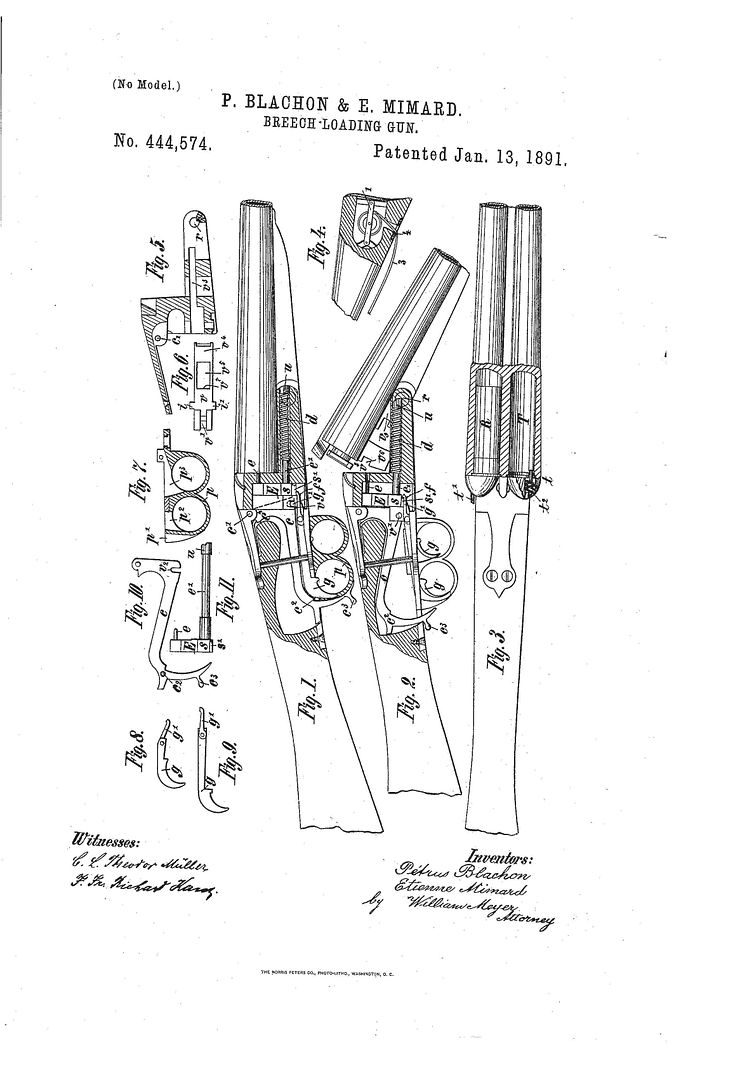
Thanks
Martin
But, the original French Patent does not:
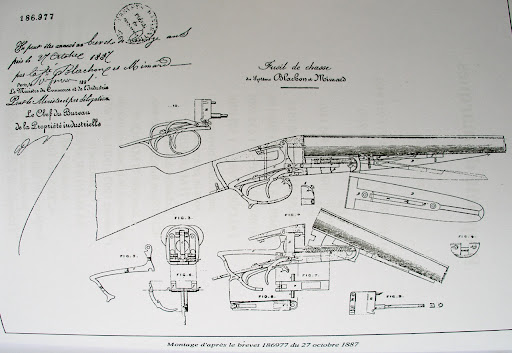
Wonder why they went with the "eyeglasses".
JC
P.S.: Size is big on purpose so you all can see all the details! jc
JC,
Thanks for sharing.
I edit my post so my picture is bigger than yours :).
HAPPY NEW YEAR FOR ALL !!!!!!!!!!
Martin
I was told the lunette guns are always black powder proofed, the more typical trigger guard is always smokeless powder proofed. Haven't had enough of either through my hands to bear that information out.
Best,
Ted
Wonder why they went with the "eyeglasses".
JC
Obvious answer to that one, JC: It's French, and it just wasn't quirky enough with the normal triggers.
Patents mean nothing in this case. The question is what kind of Ideal was the first, with 'standart' or eyeglasses type of guard. In Jean Bretton book I can see eyeglasses/lunette, whatever, triggerguard was typical for Ideal at very beginning.
Interesting bit from Ted on t-guard corresponding to proof and making a big, unavoidable visual cue to permissible ammo. Anyone ever checked even a few examples who could add some wgt. to that idea? Sounds like the sort of rational but awkward choice a Frenchman would make. Surprising the Brits didn't also adopt the lunettes for some purpose which would irritate the French.
jack
Ted, with all due respect I do not think that the lunette is an indication of smokeless proofing.
The lunette was built until 1909. The first Nitro proof was made in 1897.
This is indicated by a "R" after the model number i.e. 4R.
R stands for "renforce" (reinforced action). Of course the proof marks will show this with the crown over PJ, PS, PM or PT.
Best regards,
WC
Black powder proof is available to this day at the proofhouse in St. Etienne. The only smokeless powder listed above is PT, powder PS is a semi-smokeless. Regular proof with smokeless began in 1900, but, it was/isn't the only level of proof available, even now.
I think we need to see the flats of some more guns before we can make the call. I was told the Lunettes guns were black powder only proofed by a French firearms dealer in Lyon. He didn't have any I could look at at the time.
A good friend owns a number 6 Ideal, I think, with a regular trigger guard, in 16 gauge. Wonderful gun that fits absolutely nobody who walks upright, and choked impossibly tight in either barrel.
Smokless proofed, however.
Best,
Ted
For the record, 33,551 "eyeglass" guns were made until 1909*. I wouldn't think they were all for black powder and all proofed by a dealer.
It is my understanding that Idéals were all sold directly by Manufrance. No dealers, to
keep the prices down (à la Galazan). The guns were subjected to terribly unjustified
revues due to this in their beginnings.
JC
* Le fusil de chasse "IDEAL" by J-C Mournetas-Editions du Pecari
Ted, I would beg to differ.
The French equivalent to Nitro is "Poudre Pyroxylee".
My 1900 "Manufacture francaise d'armes de St Etienne" clearly puts the J, S, R, T, M & BN powders in that category.
The 1910 catalog also says that the S powder produces the highest pressure and therefore all R models are proofed with it.
The Proof mark is Crown over P.X. (X=J, S, T, etc.) for the Nitro powders and crown over F or S for the black powder guns, S being superior proof. Are you confused yet?
The "R" addendum disappeared in 1925 simply because almost nobody used exclusively Black powder at that point, and therefore, every gun was really an R.
The GB gun is one of 2008 built in 1900 (source:Mournetas).
As far as the chokes, standard French chokes are 1/2 and Full.
If anybody knows of an Ideal double rifle (they were made in a bunch of calibers from .303 to 450NE), please let me know!
Happy New Year!
WC-
I believe the Lyons dealer did the telling but none of the proofing, JC. And of course, he (and others like him) may have done none of the dealing, but that doesn't prove that what Ted isn't saying is false. Or something like that.
jack
Lapin,
Of course it does -or doesn't?
JC
Again, for the record:
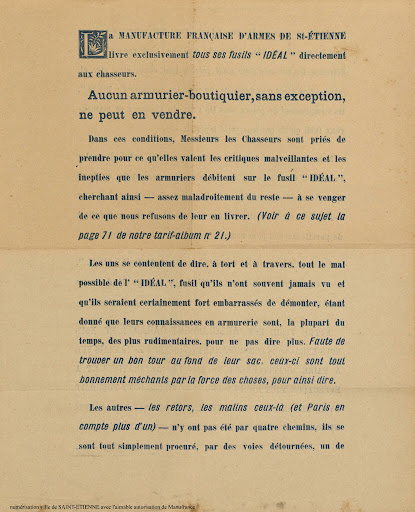
You don't need to speak French to understand what it says concerning distribution.
It also confirms that the Idéals were slandered by the gun dealers that couldn't sell them.
JC
JC, in some ways, your post raises more questions than it answers. For example: How did one acquire an Ideal? Did he have to go to St Etienne to buy it directly from Manufrance? Could they be ordered and delivered through the French postal system, or some other means? And did the practice of not selling Ideals through dealers continue throughout the gun's entire production history?
WildCattle, the French didn't use just one expression for smokeless. I've also seen "poudre vive" and, I believe, "poudre blanche". If you look at enough French barrel flats, you'll find that, outside of the required proofmarks, various manufacturers used a wide variety of proprietary marks and stampings relating to the powder, the steel, the chokes, etc.
I think we still need to see the flats of a lunette Ideal that has smokeless proof stamps applied, by a proofhouse, before we know one way or the other. I sure haven't seen enough to draw any conclusion.
The Manufrance catalog was like the Sears catalog of the same era. I'm sure they would send you, by post, anything in it, just like Sears would.
Those were the days.
Best,
Ted
Well of course it really does't make any difference what powder is used for the proof. The proof house picks powders suitable for their purpose. "MANY" guns have been proofed over the years totally with black powder & marked with a "SMOKELESS" proof. This was quite often accomplished by giving the gun the regular "Black Powder" proof with a coarse grain BP to insure the major portion of the bbl was adequately proofed while an auxillary proof was fired with a Fine grained BP giving ample chamber pressure to insure it was safe to use with the normal smokeless powders for the chambered cartridge.
The important point is not what it was proofed "With" but what it was proofed "For".
Armurier-boutiquier? Western Auto? French carries referential/connotational colorations for English speakers leading to alarming humour. I'm headed down to the gun boutique doesn't sound right.
jack
Lapin, according to my Larousse Grand Dictionnaire Français/Espagnol and then
from Español to English:
Boutique=Shop
Boutiquier=Shopkeeper
so,
Armurier-boutiquier="Gunshopkeeper".
We tend to think of "boutiques" as special shops, but... Also bear in mind I am
citing a 1890 catalague, so the language probably has had a bit of an evolution.
JC
Bonjour Larry,
Could they be ordered and delivered through the French postal system, or some other means?
As Ted points out, yes.
And did the practice of not selling Ideals through dealers continue throughout the gun's entire production history?
Je ne sais pas. But I am researching the issue and will get back on it.
Bon 2010!!!
JC
Quite right, JC. For the monolingual bumpkin, with or without extra "bucks", French on shops has its fascination. Curiously, the bread and the guns hold up to further scrutiny.
Have to think about Pipes' statement. Thought the words "progressive", "double and single base", "retardants", "explosive vs. propellant" and ball, tube and spaghettio shapes would have been of more importance? Apparently for the purpose of shotgun proof, bp of one granulation or another does it all or was presumed to do so by the proof houses.
jack
Miller's assertion is right on I would say. They were proofing for a certain pressure
so what they used is not that important.
The first proofs were done according to the St. Etienne proof house's rules dating to
1866:
-For 12 bore: 10 grams of black powder and 70 grams of nº8 shot.
Later (1920) there were different levels of proof ranging from:
-First proof: 11grams of BPnº2 and 70grams of nº8 shot for 941 kg/cm2 pressure
-Finished barrels: 10grams BPnº2 and 60grams of nº8 shot for 791 kg/cm2 pressure
-Superior proof: 14,5grams BPnº2 and 75grams of nº8 shot for 1133 kg/cm2
-Double proof: 20grams BPnº2 and 120grams of nº8 shot for 1441 kg/cm2
-Triple proof: 30grams BPnº2 and 180 grams of nº8 shot for 1726 kg/cm2
The BPnº2 is called in French "Poudre Noire Forte Nº2.
The above for 12 bore.
JC
Very interesting thread!!!
Looking at old catalog, lunette Ideals were made only for black powder at first and then smokeless powder Ideals were marked "R".
Ideals were not only sold by the "Manufacture Francaise".
This is a (bad) copy of 1917 Rasetti´s catalog and they offered Ideals:

Also in old catalogs (1910) you can find that the "Manufacture Francaise" have representaives( is this the word?) around the word.
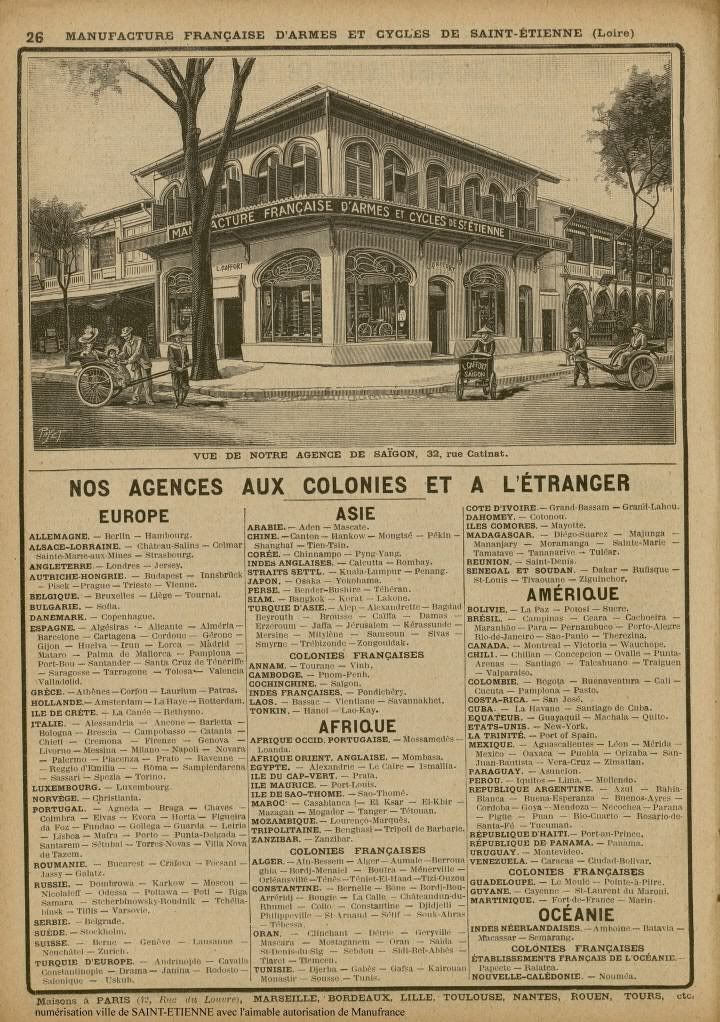
Martin
30 grams bp (462 grains) gets you the triple palms? Does all that bp fit in, say, a 65mm or 70mm hull? And 180 grams (2772 gr.) of shot? According to fuzzy math, that would be about 6.4 oz. Where does it go? Missouri pov, ya know. Is this some sort of front stuffer load for a 2 ga?
jack
Poudre S certainly is a nitro powder and not a black powder.
Here is a quote from Edward Chauncey Worden:
"According to Arms and Explosives 1907 the following are the French shotgun smokeless powders:
- J Powder composed of nitrocellulose 83% ammonium bichromate 14% potassium bichromate 3% this being a style of powder in which there is no equivalent in the United States or England
- T Powder is a gelatinized flake powder manufactured from nitrocellulose only of the highest degree of nitration and presumably gelatinized by means of acetone. Cooppal II and Shotgun Rifleite are similar.
- M Powder is composed of nitrocellulose 71% barium nitrate 20% potassium nitrate 5% camphor 3% gelose 1% and somewhat similar to the English 33 cal powders
- S Powder is an equivalent of the English 42 grain powders and the US Sporting Powders and contains nitrocellulose 65%, barium nitrate 29% and potassium nitrate 36%"
So there.
All these powders were made by a government facility which still exists: the SNPE.
"Poudre vive" is a layman term for Nitro. The official wording is "pyroxylee" avec un accent aigu bien sur.
Note that smokeless or semi-smokeless only means that it is not Black.
The 16949 gun on GB shows on its flats that it has been designed and proofed for smokeless powder. This gun was perfectly safe at time of manufacture with the early nitro powders some of which are still available today. As a matter of fact, the individual barrels were proofed once at the proof house with a superior proof (14.5 gram of Black #2 + 75gram of lead), and the finished gun was proofed twice: once in the Manufacture with the 3.46 gram (i.e 53 grains) of powder and 36gram of lead and once in the proof house with or for the S powder as evidenced by the PS mark which actually was developing a higher pressure than the T proof (PT).
The quantity of R guns built between 1898 (beginning of the R model) and 1909 (end of lunette) was probably quite small, and it is not surprising that a Lyon shopkeeper would not have seen any, especially since the majority of hunting weapons vanished during WWII. I know that I have never seen a single lunette Ideal in France, and exceedingly few post 1909 later models.
As for the Manufacture, it was primarily a mail order operation, but this was supplemented with outlets in Paris, Bordeaux, Toulouse, Nantes, Marseille, Rouen, Tours and Lille, thereby covering the largest cities all over France, allowing them to avoid another distribution layer.
In 1924 though, la Manufacture started a parallel retailing channel named "Manumodele" which retailed the "Costo" clone of the Robust. That did not last very long however.
I do not believe that it was ever possible to order a Manufrance model from a regular gunshop before it closed down.
For the afficionados, I think that Manufrance has been restarted and that it is possible to order parts (such as the slings) from regular gunshops this time.
Best regards,
WC
Manufrance "outlet" on the Rue Catinat, Saigon. Rickshaw cabbies look longingly at "safety" bikes. Velly intellesting! Anyone know if the injection-molded plastic "Simplex" derailleur found on the bargain basement 10spds of the 1960s might have been a product of MannyFrance Gun & Bike. No reason to suspect this except for the Manufrance single shotgun so named.
jack
Those proof loads were typically done before chambering the barrels. They were very long indeed.
---
I was wrong here, the "palms" proof were done on finished barrels, but did not actually require a chamber as they were much longer than the chamber.
The Ideal 16949 barrels were chambered but not assembled during proof as the "NA" mark shows.
WC-
Yes, I see the proof for finished barrels in JC's post now. Other stuff for unchambered tubes. Got it.
jack
Different company I believe.
WC-
Thanks WC. Probably another sleepy little company waiting around for Campagnolo to eat their lunch.
jack
Lapin here is the table I got the info from:
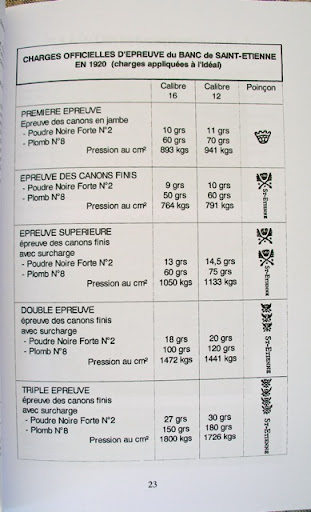
JC
Hi Beleg,
As shown in my post #172545 and below,
in France, Manu did not have distributors,
at least for the period they were making the "eyeglass" model.
They did of course have agents for export purposes as they were not an international
company.
As I posted above, thirty three thousand five hundred and fifty one guns were made
between start of production in 1887 and 1909 when the pontet-lunette was discontinued.
This from their 1910 catalogue (very emphatic I would say):
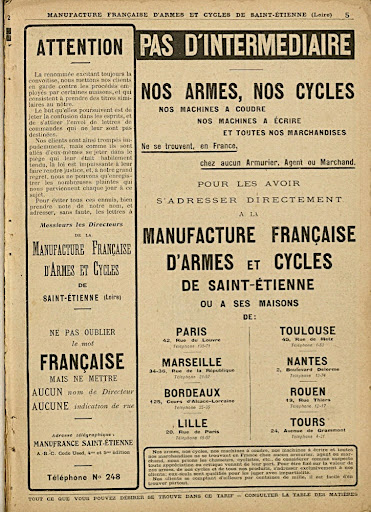
Best,
JC
JC, apparently I am not familiar enuf with the proof process alhto I have seen the old lithos in Greener of the single tubes flying off the tables into the sand. Spoke too soon and I certainly don't doubt the validity of your source or your interpretation. The tubes of my poor little 3-frond Charlin must have been stuffed from front to back. Need to do a volumetric calculation to find out just how many inches of 12 bore that "superieure" mess would occupy.
jack
Bicycles, sewing machines and typewriters also. The customary MO for a "gun" manufacturer apparently. So many examples: Iver Johnson, L. C. Smith (man rather than Co.), A. H. Fox and his successors.
jack
Do we, or, do we not have positive proof that any Lunette trigger guard Ideal guns were built and proofed to the higher smokeless powder proof, be it PS or PT?
Also, I'd be hesitant to believe that ANY guns built and proofed in St. Etienne were simply stuffed with a load of something, and marked as being proofed for something else, alá Two Piper's post.
The proofhouse I visited in St. Etienne appeared to be pretty tightly run, with excellent documentation and records.
I still haven't seen positive proof that the old shopkeeper in Lyon was wrong, as of yet.
Best,
Ted
Mon cher Lapin,
I never thought I was being doubted. Posted the table so the corresponding proofmarks
could be seen.
It should be mentioned that the Idéal barrels in general (at least the few I have seen
together with the Darne barrels) are very thin and light, so it should be said that they are of
superior quality.
JC
I'm wondering if I'm a big enuf afficionado to get a sling in here from France? Probably not. Better just fake it with a utilitarian approximation. Where's Serban? Maybe he'll post about his 16 ga. restock project.
jack
WildCattle, since there's no requirement from either the Paris or St Etienne proofhouse to place a "nitro" proof stamp on a gun, that means there really is no "official" term for nitro in French. Note that the "PV" on Belgian guns stands for "poudre vive" . . . et les Belges parlent francais.
After 1914, the only smokeless powder proof available was with T.
"Armurier" . . . that's the guy who does the work. The place he works is called "une armurerie". Which, thanks to all those r's in a row, is one of the harder words in French not to stumble over.
JC,
Sorry for my confusion.
They have a representative at my home town, I will try to find more info at local musseum.
Thanks
Martin
PS: I will have to print this thread and give it a deep read. LOL.
Also, I'd be hesitant to believe that ANY guns built and proofed in St. Etienne were simply stuffed with a load of something, and marked as being proofed for something else, alá Two Piper's post.
Note Ted that I did not specifically say that St Ettienne did this. I simply said that many guns had been so proofed. This was a practise of highly respected proof houses having world wide recognition, though unfortunately I do not currently know just where to lay my hands on the particulars. You don't have to believe anything at all you don't want to, but truth is not really dependant upon your belief of it, now is it. The only point I was really making was it is not important what powder was used in proofing, only the pressures it was proofed for.
The use of black powder for smokeless proofing was merely cited as an example. Remember in these early days all shotgun propellents were quite similar in burning rates & all were rather fast & preceded the so-called "Progressive Powders" which would come later. Black Powder was a slower burning propellent than was any of the shotgun smokeless propellents of the day. A proof charge of it actually stressed the whole of the barrel "Except" the immediate chamber area more than did the smokeless charges. By the use of a heavy charge of very fine grained black it was possible to reach proper chamber pressures for an adequate proof for the smokeless & still also adequately proof the remainder of the barel for use of any charge normally placed within the gun.
I state this as "Fact", if you so desire do enough research to prove it "Wrong", but frankly I don't really care what you "Believe".
If the gun is designed to handle loads of 9k psi & a proof pressure of 12k, or 15k or what ever is desired it don't really matter if that ressure is reached by a load of black, semi-smokeless or smokeless, just as long as it is reached, is all I was really saying & the best way of assuring that is by relying on the proof house for the proper choice of a powder to accomplish their purpose.
Nothing simple here! And the vernacular doesn't help. I assumed three palms stamped on the barrel meant triple proof but actually it's double proof (9 grams bp x 2). What I thought was double proof is actually more like 1.5 proof (superieure). Four palms equates to triple proof (9x3=27 grams). 4 means 3x; 3 means 2x; 2 means 1.5. It's a wonder I can tell a cocking indy from a--ahem--linear striker!
jack
Larry,
You forget that both the powders and proofing were done by government agencies. They all used "poudre pyroxylee" as opposed to "nitro" (which has never been used in French unlike in English) or "sans fumee" or..., so there it is, the official wording. There is a strong possibility (for which I don't have a proof yet)that it is the source of the P in PS, PT etc.
My French Dictionary shows the definition of "pyroxyle" as :
"product resulting from the action of nitric acid on a substance containing cellulose (wood, paper, etc..)", which is of course the same as NitroCellulose in English.
By the way, if you read the gun description in GB, it does show that the gun is engraved with "Poudre Pyroxylee".
As for the Belgians, they are well... Belgians, and are therefore untitled to be different.
You might recall that a screw is called a pin in England. Same story.
Best regards,
WC
Two-P, I got you right the first time :-)
Miller's assertion is right on I would say. They were proofing for a certain pressure
so what they used is not that important.
One should not quote oneself, should one?
JC
Miller,
As to whether other proof houses do/did as you say, I have no clue. But, per Lee Kennett's excellent article on French proof in "The Gun Digest" 24th edition, 1970, A smokeless proof powder load was developed for each early smokeless powder as it was introduced. Superior proof of finished arms HAD been done with black powder, prior to 1896. The proof load for powder J, and it's derivatives, J1 and J2, and powder S were introduced in 1896. Powders M, R, and S2 had their smokeless proof loads developed in 1898, and powder T in 1900.
By 1914, all but powder T had been dropped as proof powders. Powder T is still manufactured to this day.
If what you are claiming is true, there would have been no need to develop a proof load for each powder as it was introduced-which was not the case, according to Kennett. Also, according to Kennett, these proof loads varied considerably in their pressures. It would seem to have been important, at least where French proof was concerned, that a gun intended to be used with powder J, M, S, or T, or any of the derivatives, be proofed with said powder. Which, as I pointed out, is what I thought they did.
Look it up yourself.
The rules of 1928 changed much, but, black powder proof of shotguns was set at 8,800 and 11,400 for superior black powder proof. Proof with powder T was set at 12,000 PSI and 15,600 for superior smokeless proof. Note that smokeless proof is performed with powder T. Not black powder.
Believe what you want about other proof houses, I guess. They aren't relevant to this conversation.
Best,
Ted
I found another Ideal lunette model 4R.
http://www.armureriejeannot.com/manufrance_id%C3%A9al.htmI could ask for pictures if you wish.
Best regards,
WC
Would be cool to see exactly what it was proofed with. That seems to answer my question, but, like I said, the proof would be in the proof!
Best,
Ted
You weren't gone that long, Ted! Looks like you've got the yrs before 1920 locked in there if your Gun Digest guy knew what he was about. Point Schefelbein.
jack
A bit more info:
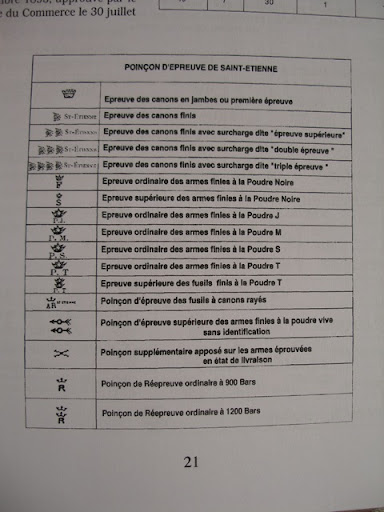
It would appear the "P" in each proofmark stands for "Poudre".
JC
There is a page similar to that, in Kennett's 1970 Gun Digest article, that includes marks from the proof house in Paris. It is a great article, and he did a series on them for European proof houses in the same periodical, published in different years.
Wild Cattle, if you can get a picture of the barrel flats and proofmarks on that lunette Ideal, it would be fantastic. I'll cautiously note that if it was proofed for anything other than powder T, say PM, PJ, or PS, it would likely be unwise to run off to Wal Mart and procure a box of whatever 2 3/4" is for sale today to shoot in it. Kennett noted in 1970, that it was often difficult for the 12,000 PSI minimum to be reached with the powders used prior to powder T. Further, even if it was proofed for powder T, that is an old, and light gun, and it would be wise to subject it only to lower pressure ammunition. Ere on the side of caution, I always say.
Best,
Ted
Ted, could you scan that paper?
I found yet another one here.
http://www.gournetusa.com/Ideal.htmAs for the discussion about proofing loads, the British did exactly the same, as they proofed the barrels with Black, and the guns sometimes with Schultze or EC or Rifleite, or Amberite or Cordite... per the maker's request.
In general the French makers battled themselves with heavier proofs to the point of silliness. This seems weird, but the majority of shells were home-made and hunters were pushing the envelope to get that hare at 60 yards, so they liked heavy proofs.
Another remark concerns the equivalence of pressure measurements.
A French kg/cm2 number might not be equatable to xxx PSI, as the measurement methods might be completely different. I don't have any data on this but one should be careful with simple translations.
Certainly, all usual precautions apply to an old gun.
Best regards,
WC-
Wildcattle,
Thanks!
You have found one nitro proofed lunette!!!!!!
It is a N° 3R.
I forgot this page even thou I visit the forum.
Martin
Kennet specifically notes PSI. I don't know if that is incorrect, or not. I have a photo copy of the whole, rather lengthy article, and I will see about getting the charts in it scanned. Hope I'm not violating any copyrights.
After reading the Ideal info Wild Cattle graciously posted from Geoffroy's site, and seeing the timeline for production of lunette Ideals, including the years that R proofed lunette guns were available, the little old gun dealer in Lyon may not have had an actual fact, BUT, it seems like it's usually a pretty darn good rule of thumb. Proof with powder other than PT can't really be considered smokeless proof by today's, or even, post 1900 standards. Lunette guns were in production until 1909. Powder T became the only proof powder in 1914. A lunette Ideal proofed with powder T is likely a rare bird, not impossibly rare, but, rare enough not to matter today. Hence, a lunette proofed with powder J, M, S, or anything other than powder T, was smokeless proofed FOR THAT POWDER, IN THAT ERA. It really can't be considered to be smokeless proof by today's standards.
Best,
Ted
Nitro proofed lunnete Ideal 6RE s/n 209xx (1899)


Which powder, Geno?
Best,
Ted
In JC's scan of the St. Etienne proof house marks, the mark of "superior proof of finished guns to[?] the live powder without identification" is two arrows or shishkabobs. What is "without identification"? The powder used in proof? Makes no sense as my Ideal is stamped with these arrows followed by PT (powder "T") on barrel flats and water table. Does this point to 2-pipes' scenario of a generic/perhaps bp perhaps not/as long as it produces the required pressure proof load or is poudre T the proofing powder? Gun also marked "pression 1100 kilos" which I take to be 1100 BAR. This 1930s Ideal should have a higher service pressure than the current 800 BAR proofed CIP guns, should it not? What would that service pressure be (with of course the usual nod to safety in "old" guns?
jack
Let's just cut down to the bottom line here, there are any number of "Smokeless Powder Proofs" applied to guns of various proof houses, some naming the powder, some not. "MANY, MANY" of these proofs are not considered adequate for modern day SAAMI spec (ala Wallie World) shells. If the proof load was such that the gun was considered proofed for say a 9K psi load, then if your load does not exceed that 9K psi, then it doesn't matter if it was proofed with, or if you are loading; Black, Poudre M/T, Shultz, EC, Mullerite or " DuCules Purple Polka Dot".
The two points of importance are to what pressure level was it proofed to handle & what pressure level are you shooting. Now that doesn't seem too hard for a person of reasonable intelligence to understand.
It is not necessary that we be able to obtain the powder these old guns we talk about here were proofed with in order to obtain a load we can safely fire from them. Very fortunate, otherwise they would all be WallHangers.
Manufrance catalog 1900. Pages 2-8.
Catalogue 1900 There are a lot information about French nitro powders and guess answers to all questions.
WildCattle, "pyroxylee"--unlike "nitro" in some other countries--was not an officially required stamp of the French proofhouses. Therefore, there really isn't any "official" French term for smokeless. It's similar to "arquebusier" and "armurier"--both of which you will find on French guns, thus neither being the "official" term for gunmaker, since neither was a proofhouse marking. French for smokeless proof, as far as the proofhouses were concerned: either star or crown over PT. (And the P stands for poudre, not pyroxylee. On that issue, if you wish, I could quote you General Journee.)
Rabbit and JC, whether 3 crowns meant double proof or triple proof depends on when the gun underwent proof. According to Kennett (agree with Ted that his article is excellent), it originally meant double proof at 20,500 psi. It's now (since 1924) called triple proof . . . but the pressure reduced to 18,000 psi (still darned stout!) The previous superior (two crowns) is now called double--which makes sense, given the number of crowns. But leave it to the French to try to confuse us!
Miller, the idea in proof was NOT that you would run your ammunition at "proof" level. There was a service load, that was a percentage of the proof load, that was deemed safe. Use of a proof load, especially French proof, in a hunting gun, would likely lead to detached retinas in short order, never mind what happened to the gun.
Don't you remember the photos of those proof loads that Sherman Bell was trying to blow up old doubles with, that had lots of warnings all over the box, stating they were proof loads, and not to use them for anything else?
We don't run proof loads in our guns.
Lapin, I've only seen those kabobs in pictures, never on a gun. Not sure which level of proof is on your Ideal, but, it would be either 12,000 or 15,600 units of whatever pressure they were using that day-I'm confident you can use it with whatever, but, low pressure loads in old doubles is our mantra, usually.
That said, my R10, out of proof for several reasons, gets whatever I give it, up to and including 1 1/4 oz Federal "Pheasants Forever" loads of number 5 shot-a stiff cocktail in anybody's book. And, it's been fed that, during pheasant season, for years.
No harm to report. I might not be able to take it, as I approach 80 years or so.
Time will tell.
Best,
Ted
If 1924 is a French proof rules adoption watershed (perhaps not the only one?), both of my French doubles are this side of it so maybe I've a got a little better handle on the palms (Charlin) and the arrows (Ideal). And perhaps not so don't anyone rest easy that you won't have to repeat this info another ten times for Mr. Short Term Memory. In either event, many thanks! EDIT: I'll get a pic of the shishkabobs and post, Ted.
JC, I think I've slo got a pretty good handle on the sling disconnect. Got a length of 1/4" steel bar out of the scrap tonite and I have Jeff's drwgs. which you supplied. I've decided to leave the chingus attached to the barstock at the exterior arc that fairs to the opening in the ferrule (another sort of useful handle) and scribe that and cut off and finish after the clevis end is done and the pin fitted. May mock one up at work from soft plastic to get a little better idea how to proceed. I've got an old Rockwell Delta bandsaw with metal cutter reduction so I guess the "milling" is going to be that and files.
jack
Miller, the idea in proof was NOT that you would run your ammunition at "proof" level.
Well I reckon its a total lost cause to even try & discuss anything with someone too totally Ignorant to understand anything they read. I of course did not in any way even imply that a gun should be shot with the proof load. In fact some several pages back (you can go back & seek it out if you care to) I mentioned that a gun intend "For" 9k psi loads might be proofed @ 12K or even 15K psi. When I on several occasions mentioned it was important to know at what level a gun was proofed "FOR" that meant the service load, not the proof pressure.
If there may be 3 million people following this post Ted I think everyone but you understood what I was saying.
But let me say it just one more time @ spell it out very clear, just for you;
"IF" I want a gun proofed for 9,000 psi loads for use with smokeless powder & I want it proofed @ 50% higher pressure ie 13,500psi. Now it don't make a Rat's A**" what powder the proof house uses, Black, Green, Purple or Pink as long as the pressure reaches that 13.5K psi, they can then stamp it as being proofed "For" smokeless powder "For" a 9K psi service load.
Proof houses very early on realized it was not really desirable to stamp the "Proof Powder" on the bbl as there were a few folks out there too ignorant to understand just what this meant, so standardized smokeless proof marks were adopted, that is by everyone EXCEPT the FRENCH, it took them a while longer to catch on.
Now if a proof house decided to use a fine grain black powder & the (proof) load produced that desired 13.5k psi pressure then they could (& in some cases indeed did), stamp that barrel as having a "Smokeless Powder Proof" suitable for use with a 9K psi load of smokeless powder. Its all really quite simple, what's important is what the barrel is proofed "For", not what its proofed with.
Larry,
I did not understand what your point was.
Of course, "pyroxylee" is not required to be marked on the gun. However, it is the *only* French word which applied to Nitro-cellulose based propellants in the early 1900s. Nitro or any derivative is just not in any French dictionary of the period and Smokeless or "sans-fumee" is way too vague and decidedly not scientific. By the way, Nitric acid was actually known as "acide azotique" in that time frame, Nitrogen is still "Azote", therefore Nitro anything was a non starter (except for nitro-glycerine which was a trade mark I believe).
By the way "poudre", even though widely used is not correct either, as the T is not really powder but comes in flakes.
As for the proof in the PT, I was looking for the actual regulation text which is the only way to actually prove this.
Anyways, I guess it's time to call it a day.
Best regards,
WC-
That sure is a magnificent gun, Geno.
WC-
here is the "brochette".
http://www.cabelas.com/cabelas/en/conten...ideal20_07l.jpgI don't know what that text means, maybe no serial number? weird.
WC-
Larry,
I did not understand what your point was.
Of course, "pyroxylee" is not required to be marked on the gun. However, it is the *only* French word which applied to Nitro-cellulose based propellants in the early 1900s. Nitro or any derivative is just not in any French dictionary of the period and Smokeless or "sans-fumee" is way too vague and decidedly not scientific. By the way, Nitric acid was actually known as "acide azotique" in that time frame, Nitrogen is still "Azote", therefore Nitro anything was a non starter (except for nitro-glycerine which was a trade mark I believe).
By the way "poudre", even though widely used is not correct either, as the T is not really powder but comes in flakes.
As for the proof in the PT, I was looking for the actual regulation text which is the only way to actually prove this.
Anyways, I guess it's time to call it a day.
Best regards,
WC-
WC, the Belgians have used "PV" (poudre vive) ever since 1898. The fact that you'll see "pyroxylee" on some French guns means nothing, other than the fact that some French gunmakers chose to use that term. Others didn't use any term at all; others used poudre vive. Another analogy would be to the terms "lisse" and "cylindrique", either of which might be found on the flats of a French shotgun barrel which has no choke.
And while the term "powder" does originally derive from the powdery consistency of the material, saying that PT isn't really a "powder" because it comes in flakes is just downright . . . well, FLAKY.

Many other powders also consist of flakes, and we have modern powders that are ball powders. But they're still all powders--because "powder" in that sense means the propellant used to drive a bullet or shot charge, regardless of whether it comes in ball, flake, or some other form.
And I'm not quite sure what you're looking for concerning "the proof in PT". According to Kennett, post-1924 smokeless proof was at 12,000 psi with PT; superior proof at 15,600 psi.
As for what the "P" stands for, the following from "Tir des Fusils de Chasse", by General Journee, edition of 1949:
"Aucune des poudres experimentees ne s'est montree superieure a la poudre T." The book contains numerous other references to "poudres S, J, M", etc. Thus, the P in the abbreviation is clearly "poudre" and not "pyroxylee".
WC, the Belgians have used "PV" (poudre vive) ever since 1898. The fact that you'll see "pyroxylee" on some French guns means nothing, other than the fact that some French gunmakers chose to use that term.
Larry, it seems you didn't take an advice and didn't read Manufrance catalog 1900 pages 2-8.
(Sorry, but sign Eprouve Fini Poudre Pyroxylee indicates gun Nitro Proof and words Poudre Pyroxylee means Nitro Powder)
Geno . . . je parle assez bien francais, merci beaucoup. I have no trouble understanding what the term MEANS. The question is whether "pyroxylee" has any OFFICIAL status. My point is that you do NOT find "poudre pyroxylee" as an official proofmark from either of the French proofhouses, whereas you DO find "nitro" as an official proofmark on guns from various countries (England, Germany, etc). The terms "poudre vive" and "poudre pyroxylee" are perfectly interchangeable, and in fact the former has "official" status (as in the Belgian "PV" proofmark). What Manufrance chose to put on its guns, in addition to official proofmarks, is immaterial. Once more . . . the OFFICIAL French proofhouse designation for smokeless powder proof is PT under either a star (Paris) or crown (St Etienne). Maybe Manufrance figured they needed to spell it out for people who didn't understand what the proofmark meant.
I have to agree with Larry, that as I posted on page 7 of the thread, after seeing the
proofmark table, the "P" stands for Poudre that in this case means "gunpowder" and
not just "powder". I should also say that the first definition of "poudre" in my trusty
Larousse already cited says "pólvora" or "gunpowder". There are even sayings using
poudre in that meaning: in n'a pas inventé la poudre, he didn't invent gunpowder.
The pages on the 1900 Manufrance catalogue that Geno mentioned are worth reading
as they include patterning and pressure tests using different types of poudres.
Describing Poudre "T" they say it "100% cotton" (literal translation as I know nothing about
gunpowders), in very light flakes that if you happen to drop will fly to the four corners of
the room and you will not be able to pick up; also that when reloading it should not be
pressed down, that first quality shells with efficient primers and a good rolled crimp should
be used for optimal results.
JC
I always thought MF guns that had the 5-palm
punch marks on the flats meant that the barrels
were extra stout. Is this not accurate?
What do the palm marks mean and why do some MF guns
have 3 vs. 5?
Thanks,
-Jim
Larry, I don't care about official status of early nitro proofs since we have to follow and try to keep low pressures in old guns. I did say Poudre Pyroxylee is Nitro Powder and with words Eprouve Fini means Nitro Proofed.
Let me remind you no one American nitro proof got no official status.
Nitro or not nitro proofed for pre-war guns such as Ideal is a just matter of price (maybe). Both nitro proofed and not nitro proofed guns could be used with modern nitro powders or nitro-for-black substitutes today.
Actually all this is useless argument.
The palm count is akin to a grade.
In damascus barrels, it was linked to the number of rods used.
It is really only a loose indication of a higher strength.
MF does not really state what the criteria are. However, the 5 palms has been at some point the only one proofed for the "epreuve superieure".
Best regards,
WC
Martin, beg to differ.
Palms, ranging from one to five after Acier Hercule indicate the quality of the steel
used to make the barrels, they are not indicators of pressure proof.
Unfortunately the proofmark looks a lot like the palms, but in reality it is more like
two crossed feathers with a crown in the middle and three dots followed by "St.-Etienne".
Easy to confuse.
Of course the more the palms the better and sturdier the barrels.
Here you can see the proofmark for "épreuve supérieure des armes finies",
the arrows through the circles followed by the Poudre used "T" and the designated
quality of three palms for the acier Hercule used.
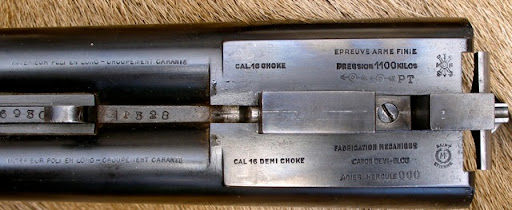
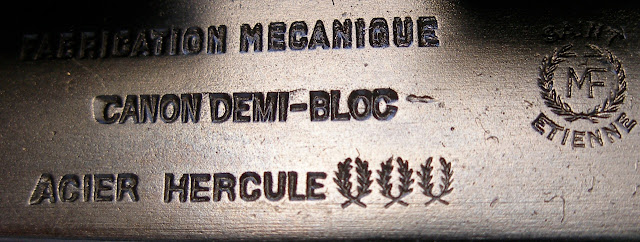
As you can see the palms are not the same as the proofmarks. No crown, no dots.
JC
JC,
You are right and Im wrong.
I just delete my post, Im very busy with some articles and read this post too lightly considering the experts in it.
Sorry I thought he was talking about St-Etienne plams.
Martin
I believe that "100% cotton" comes from the provenance of the cellulose in the powder making process. Some nitro powders such as S were made using wood cellulose.
My comment on the powder word was intended as a friendly provocation, not to be taken too literally.
As for the PT, PJ, PS, PM actual meaning the only proof will be in the text of the official rule that defined it. That's gonna be hard to find...
I have zero proof of this, it's just a hunch based on my general knowledge of the French bureaucracy, and a number of relevant readings from that time frame.
Quant a General Journee (bless his soul), he might be just as full of s**t as the Lyon Armurier.
Best regards,
WC-
We have to be careful when using old BP guns.
As you can see in this picture the owner never know he have a black powder gun and use it with modern ammo.
Even thou 16 Ga ammo is much lighter than 20 and 12Ga (here in Argentina), you can see this Ideal N°1 made in 1901 is off face.
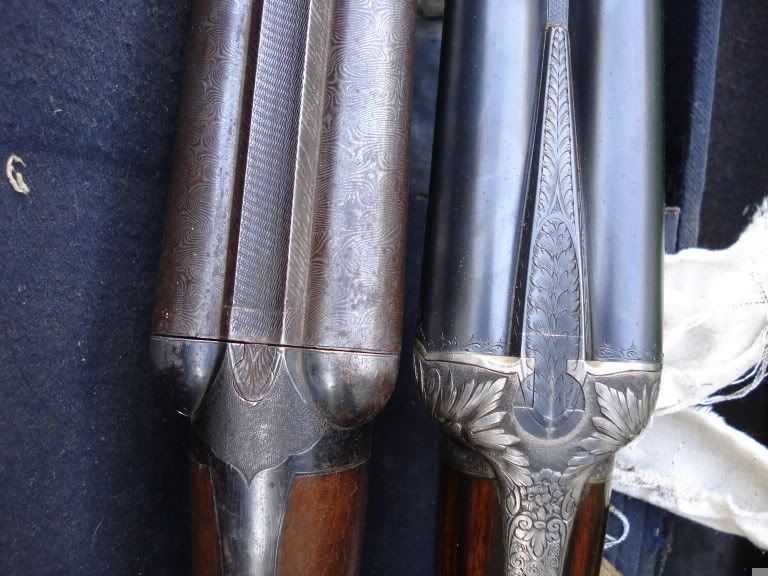
Martin
Looking at the ArmurieJeannot site, under Armes D'Occasion, they have "Mixtes", combination guns: SXS, Superposes, and "Basculantes" Googling Basculantes gives us dump trucks for sale in India and up and over garage doors in New Brunswick a bilingual Canadian province" - portes basculantes.
Thye pic in the catalogue shows a very chubby actioned gun. What is it? A three barreled gun
Comme Le Colonel LeBrun (LB) je puis parler quelques Francais, mais "basculantes"? Expliquez moi, s'il vous plait!
Michel
Beleg2,
Sorry, I could/should have been more clear.
That table that you posted momentarily was great reference though.
Thank you.
Jaycee,
Thank you for clearing that up for me.
-Jim
I see that M Jeannot requires 2980 euros (approx $4295 US for the lunette Ideal for sale on his site
Mike
WC, from this page in the 1900 Manufrance catalogue it could be inferred that the
P is either for Poudre or for Pyroxylée, so...
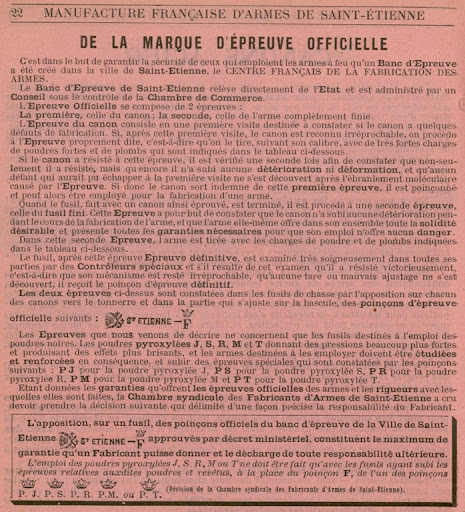
Best,
JC
P.S.: Crown over F is for black powder proof with "Poudre Forte Nº2", so I imagine
that is where the F comes from. jc
JC, I have also misinterpreted the "palms". My Charlin has three of the crown/feathersa/stars couchant on a bed of barrel followed by St. Etienne. My minimalist "proofs of the world" says three of these whatzits indicate proof in finished state at 1300 Kg per sq. centimeter. The Acier Hercule stamps look like laurel wreaths which I suppose is what makes them "palms".
jack
No problem Jim,
I post it again, just for the record.
I strongly recomend downloading old catalogs on St Etienne page. I have the in my PC for reference.
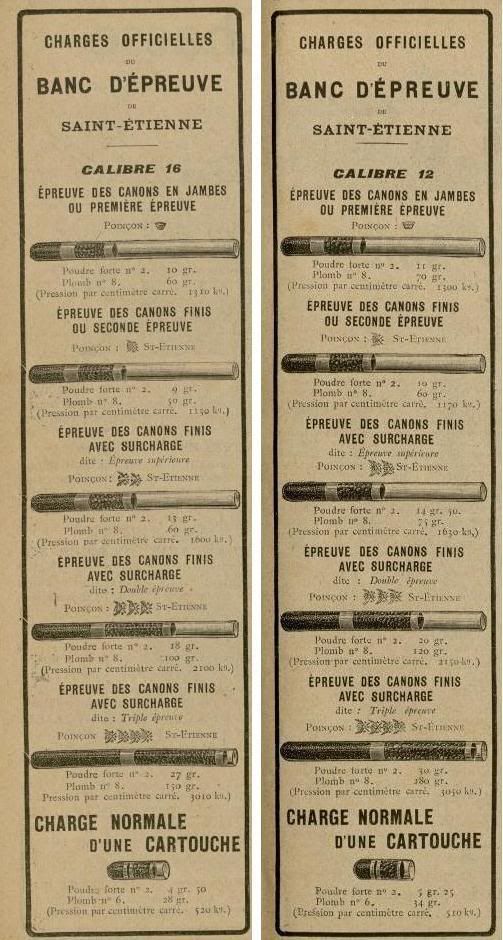
BTW: I read about a Jean Bretton book. What is the tittle?
Martin
Mike, "basculer" means simply to tip, tip up, or tip over. "Basculante" would refer to break-open doubles, and would leave Darnes out in the cold. And I think the comparison between a dump truck dumping and the break-open action of a shotgun is a pretty good one.
The French gun term I always find interesting is "les ailes", or wings--referring to sideclips.
Miller,
You are dreaming a fantastic dream if you believe there are 3000 people reading a double gun board, let alone 3 million. But, I digress.
Good to see that you finally got around to using the correct term, "Service Load", as used at the proof house. It would seem to show that ignorance is correctable.
Kennet has pretty much blown your theory that "anything goes" with proof powder, as long as it makes X amount of pressure, out of the water, at least when talking French proof, but, hey, I'm open to the idea that you could prove this happened somewhere else.
So, prove it.
As to the French "catching on", to use your words, every single new French gun I ever ordered had that neat little stamp, PT, under a crown.
So, when did they "catch on" and stop marking their guns with the powder used?
I'm curious to know.
Best,
Ted
Ted, in case you missed it, Wild Cattle's post #17802 this thread has a foto of the flats of the Cabella's 20 ga. which someone, Sliver? Le Fusil? purchased a few wks ago and the "shiskabobs" or skewers are present on that one. The "knuckle duster" Ideal at GunBroker is gone.
jack
JC,
It's possible that the F might be a proxy for "fini" in "Fusil fini" i.e not the barrels only. However there is no way to be sure until the proper "decret ministeriel" is unearthed, which would be no small feat.
It is interesting to observe the immediate adoption by the Manufacture of the St Etienne proofing.
At that very time, other makers (such as Bernard) were using a legal loophole to avoid proofing entirely, but the Manufacture was a very early adopter of the early nitro powders and of the corresponding proofs. The first R model (1897) appears at the same time of the first PX stamp (1896). Certainly, the geographical proximity had to be useful in establishing such a close collaboration.
On a slightly different subject, Mournetas states that the first
Hercule steel barrels show up in 1900, which means that everything before that was in Damas Eclair, even on the R models.
Oh and by the way, Geno's gun would be from 1903, not 1899.
Best regards,
WC-
According to Baron Engelhardt's article on French proof, the crown over F was the normal St Etienne black powder proof, with "poudre forte", for arms in the finished state (1897 on)--so F for either forte or finie would make sense. (Paris proofhouse equivalent was the Paris coat of arms--sailing ship in a shield--under a crown.) Superior black powder proof: crown over S, St Etienne; normal proofmark repeated twice, Paris. According to JC's text, either of those were replaced by the PT/PJ etc mark if proof was with a smokeless powder.
General Journee has some scathing remarks concerning the loophole left by the French government for gunmakers to avoid official proof.
Bonjour Larry,
Riffling through some Mournetas books I have been lent, it is mentioned in all of
them, as you say, that a crown over F is: "épreuve ordinaire des armes finies à la
poudre noire", i.e. normal St. Etienne black powder proof for finished guns. Also
mentioned: Poudre noire dit "Forte", black powder called "Forte", thus the "F".
Proof Charges for 12 bore by decree of July 10, 1897:
10 grams of black powder "Forte" and 70 grams of shot.
Also mentions, as you say, that a crown over "S" is "épreuve superieur des armes finies à la
poudre noire" not to be confused by a crown over PS that denotes proof using
powder pyroxylée "S". This leads be to believe that the "P" does stand for Pyroxylée.
JC
P.S.: Here is an old Gastinne Renette with the black powder & Paris? proof:

If Im not wrong again

this is a 1901 black powder damascus Ideal.
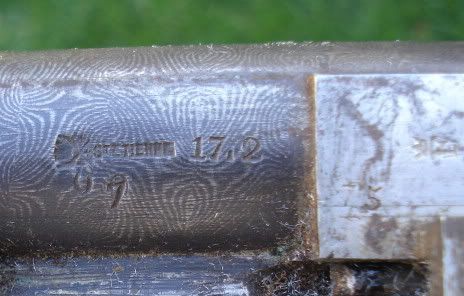
Martin
Hola Martin,
You are right.
16 bore finished barrels proofed with 9 grams of black powder "Forte" and
60 grams of Nº8 shot for a pressure of 893 kgs per square centimeter or
12,701.44 psi
JC
JC--I can't make out a Paris proof in your photo. I see what appears to be a proprietary Gastinne Renette mark (GR) on each barrel. I don't think the mark between the name and 65 is a Paris proofmark, which looks like a shield with a sailing ship coat of arms, surmounted by a crown. Perhaps a proprietary barrelmaker's proof?
I don't have a photo of the barrel flats to post right now, but I have an 1898 20 bore with 3 palm Hercule steel. It has the lunette trigger guard and I've alway thought that it was proofed for nitro.


